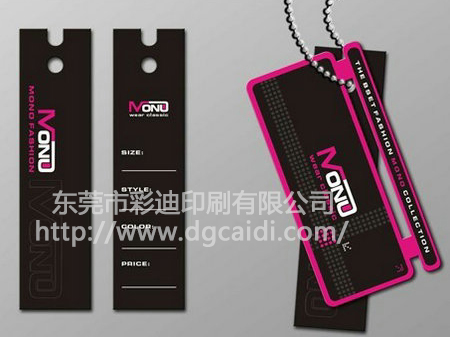Categories
Contact us
Tel:0769-85519892
0769-85042981
Fax:0769-85506493
Mobile phone:18902618399
Contact:Mr. Xie
Documentary clerk:
18922542952 Miss Zhang
E-mail:hu@dgcaidi.com

What should be noted when printing clothing tags
In the clothing industry, the small tag is not only a carrier of product information but also an extension of the brand image. When consumers receive a piece of clothing, they often carefully examine the tag first. From the material, touch, printing process to the accuracy of the information, any detail may affect their impression of the brand. Therefore, the printing of clothing tags needs to take into account both professionalism and aesthetics. The following key points cannot be ignored.
I. Design Stage: Accurately convey the brand tone
Design is the core of clothing tags and needs to be deeply in line with the brand positioning and the preferences of the target audience. High-end brands usually pursue simplicity and grandeur, opting for minimalist lines, understated color combinations, and complemented by techniques such as gilding, silvering, and embossing to create a luxurious texture. Fast fashion brands, on the other hand, pay more attention to lively and cheerful styles, using rich colors and interesting patterns to quickly catch the eyes of young consumers.
In terms of information layout, it is necessary to ensure that key contents such as product names, ingredients, washing instructions, and sizes are clear and easy to read. Avoid making the text too small or too dense due to excessive pursuit of design sense. Meanwhile, the design draft should be in vector files with a resolution of no less than 300dpi, and a 3mm bleed should be reserved to prevent deviations in the later cutting process.
Ii. Material Selection: Balancing texture and practicality
The material of clothing tags directly affects consumers' sensory experience. Paper materials have become the most commonly used choice due to their high cost performance and strong plasticity. Coated paper has a smooth surface and high color reproduction, making it suitable for mid-to-high-end brands with high requirements for printing effects. Kraft paper has a simple texture and natural environmental protection properties, and is often used in casual and outdoor clothing brands.

For children's clothing, underwear and other close-fitting garments, the safety of the materials is of vital importance. It is recommended to choose materials that have passed environmental protection certification and are printed with soy ink to avoid chemical residue. In addition, special materials such as silk, leather, and PVC can enhance the grade of the tag. However, it should be noted that these materials are difficult to print and have relatively high costs. Therefore, careful selection should be made in combination with the brand's budget.
Iii. Printing Technology: Details determine quality
The quality of the printing process directly determines the final effect of the tag. Among the common printing methods, offset printing is suitable for mass production, with precise color reproduction and is ideal for complex patterns and multi-color gradient designs. Digital printing does not require plate making and can quickly respond to small-batch and personalized demands, such as customizing limited edition tags.
The surface treatment process is also the key to enhancing the texture of the tag. Lamination can enhance wear resistance and water resistance. Glossy film can make the tag brighter, while matte film presents a low-key and high-end feel. UV partial varnishing can highlight key information such as the brand LOGO. The gilding and silvering processes can instantly enhance the visual impact. The embossed texture endows the tag with a unique touch, enhancing consumers' memory points. However, different processes have specific requirements for materials. For instance, hot stamping is more suitable for operation on smooth surfaces, while embossing requires thicker paper and process tests should be conducted in advance.
Iv. Information Accuracy: Avoid low-level errors
The product information on the tag must be accurate and error-free. Any mistake or omission may raise consumers' doubts and even face legal risks. The ingredient labels should comply with national standards. The washing instructions should be clear and easy to understand. The size chart should be consistent with the actual product. It is recommended to conduct multiple proofreadings before printing. If necessary, multiple departments such as legal affairs and quality inspection can be invited to jointly review to ensure the accuracy of the information.
V. Quality Control: Strict supervision throughout the entire process
From the entry of raw materials into the factory to the delivery of finished products, a complete quality control system needs to be established. Raw materials need to be sampled and tested to ensure that the materials and inks meet environmental protection and safety standards. During the printing process, it is necessary to monitor the equipment parameters in real time to prevent problems such as color difference and inaccurate registration. In the finished product inspection stage, a comprehensive check should be conducted on dimensions, cutting accuracy, surface treatment effects, etc. Defective products should be reworked in a timely manner.
Although the clothing tags are small, they carry the quality and reputation of the brand. Dongguan Caidi Printing Co., Ltd. strictly controls every link such as design, materials, craftsmanship and information, and can create tags that are both functional and artistic, adding points to clothing products and contributing to the improvement of brand image.







